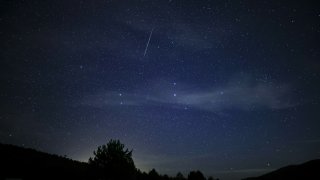
INTERNATIONAL STATION FLY-BYS
The International Space Station will make flybys across the North Texas sky this month. The ISS appears as a fast-moving star across the night sky.
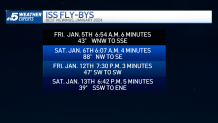
The International Space Station rotates around the Earth at a speed of 17,500 mph. The ISS rotates about its center of mass at a rate of about 4 degrees per minute so that it will complete a full rotation once per orbit. This allows it to keep its belly towards the Earth. One revolution around the planet takes about 90 minutes (16 per day).
Get DFW local news, weather forecasts and entertainment stories to your inbox. Sign up for NBC DFW newsletters.
Also, the International Space Station lies at an altitude of 250 miles above the Earth. By the way, that is 1.32 million feet. Most commercial airplanes fly between 33,000 to 42,000 feet.
THE QUADRANTID METEOR SHOWER
The Quadrantid meteor shower occurs between December 28th, 2023, and January 12th. It peaks the morning of January 4th and is best viewed in the hours before dawn.
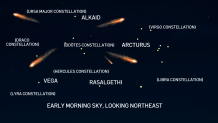
Like all meteor showers, the Quadrantids are named after the constellation the meteors appear to come from in the sky. In this case, it is an old constellation that was called Quadrans Muralis in the 1800s, when the shower was discovered. Now, this patch of the sky is part of the Boötes constellation.
Local
The latest news from around North Texas.
At its peak in the early morning hours, up to 110 meteors are visible each hour, with the event often being associated with particularly bright meteors called fireballs. To best see the Quadrantid meteor shower, go to the darkest possible location, away from urban light pollution. You don't need any special equipment like telescopes or binoculars to view the event.
THE MORNING PLANETS
For the first part of January, three planets will line up before sunrise. Catch a bright Venus, Mercury and Mars in the predawn eastern sky. Also, note that a star, Regulus, will be near Venus.
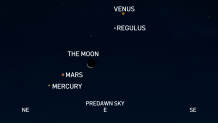
Mercury averages a distance from the Earth at 48 million miles and from the Sun at 36 million miles. Venus's distance from the Earth varies from 24 million miles to 162 million miles. Mars averages a distance from the Earth at 140 million miles. The closest recorded distance to Mars from Earth was recorded in August 2003 when the two were 34.8 million miles apart. According to NASA, the two will not be that close again until the year 2237.
Regulus is a multiple star system consisting of at least four stars. It lies 79 light-years from the Sun.
AN EVENING DELIGHT
Saturn will be visible in evening sky for the month. You'll find the ringed planet glowing 30° high in the southwestern sky an hour after sunset.
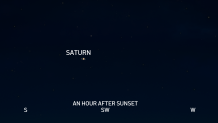
Saturn's distance varies from the Earth. When the two are closest, they lie approximately 746 million miles apart, or eight times the distance between the Earth and the Sun.
At their most distant, when they lie on opposite sides of the Sun from one another, they are just over a billion miles apart, or 11 times the distance between the Earth and the sun.
THE FIRST FULL MOON OF THE YEAR
The first full moon of 2024 will take place in January. The moon will rise on January 25th in the east-northeast sky at 5:56 p.m.

That moon, known as the "Wolf Moon", gets its name into references to the hungry packs of wolves that prowl during the winter months.
MOON PHASES
Also, check out other phases of the moon this month.
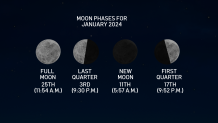
On January 29th at 2:14 a.m. CST., the moon will be at apogee, its farthest from the Earth for this orbit at 252,138 miles.
On January 13th at 4:34 a.m. CST., the moon will be at perigee, it is closest to the Earth for this orbit at 225,102 miles.
Please enjoy these events happening in the night sky this month. Until then...Texans, keep looking up!



